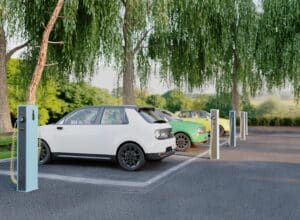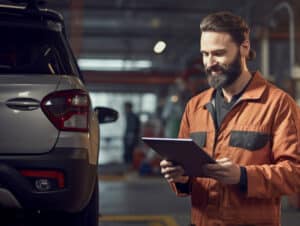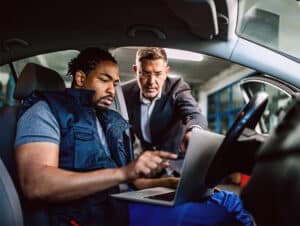Earlier in November, we hosted an automotive webinar that took a deep dive into the exciting evolution of automotive retail in our increasingly digital world. The event brought together thought leaders, influential decision-makers, and representatives from the automotive business landscape, all eager to explore the unfolding dynamics of the industry.
Titled “From showroom traffic to virtual visits: Adapting automotive retail to the digital age,” our webinar was privileged to host a distinguished guest speaker—Frank Böhmerle, Chief Technology Officer at AMAG Automobil und Motoren AG. His insights illuminated the technological frontiers shaping the automotive landscape, providing a compelling narrative on how our industry is navigating the digital era.
The future of automotive retail
Magnus Guðjónsson from our automotive industry pre-sales team, served as moderator for the session and set the stage by illuminating the expansive landscape of the future in automotive retail. Acknowledging the vastness of the topic, he artfully conveyed that the journey ahead cannot be fully unraveled in a single session. Magnus underscored the essence of not just transitioning from paper-based processes to digital but advocated for a more profound shift towards integrated, connected systems.

 In navigating this digital frontier, Magnus placed a spotlight on the critical role of customer relationships in this evolving landscape. He emphasized the urgency of comprehending and adapting to shifting customer preferences. According to Magnus, dealers and automotive retailers must diversify their offerings, even if it means forging unconventional partnerships and collaborations, in order to meet the evolving needs of their customer base.
In navigating this digital frontier, Magnus placed a spotlight on the critical role of customer relationships in this evolving landscape. He emphasized the urgency of comprehending and adapting to shifting customer preferences. According to Magnus, dealers and automotive retailers must diversify their offerings, even if it means forging unconventional partnerships and collaborations, in order to meet the evolving needs of their customer base.

The notion of thinking outside the box became a recurring theme as Magnus encouraged both Annata and industry players to venture beyond their comfort zones. He emphasized the importance of fostering partnerships for technical solutions within the industry and reiterated the adaptability of businesses to market trends as a guiding principle throughout the webinar.
Automotive retail is changing fast
Phillip Parfitt, a pivotal member of Annata’s Automotive industry team, leveraged his extensive international experience to shed light on the industry’s transition toward a more digitally-centric paradigm. Offering insights into strategies for staying ahead in the rapidly evolving automotive market, he underscored the importance of a proactive approach and the risks associated with inertia.
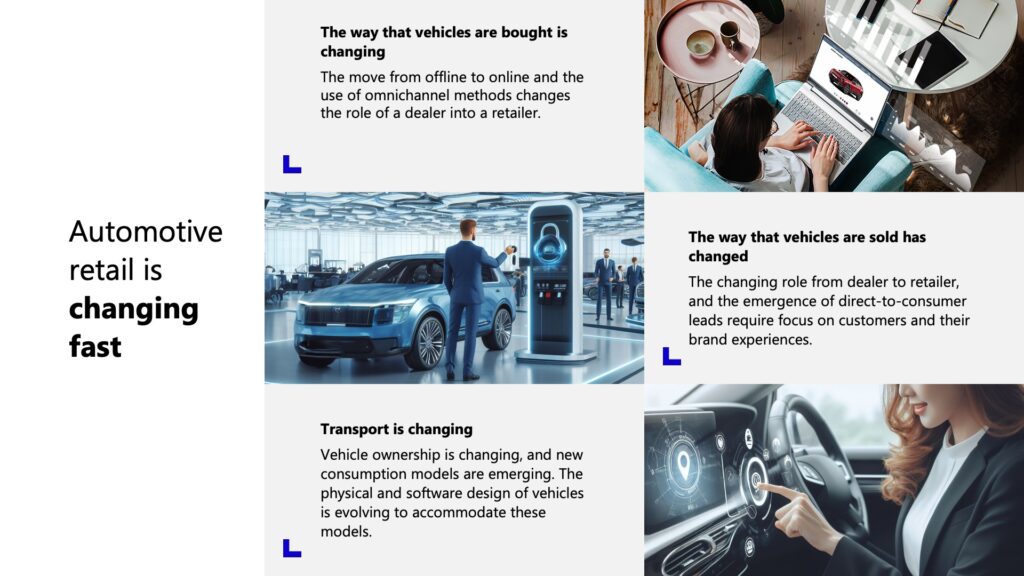
Identifying three fundamental shifts impacting the automotive industry, Phillip emphasized the transformation in how vehicles are bought, sold, and used. The preferences of future generations, particularly in online interactions and social media for experiential and social aspects rather than the vehicle itself, are reshaping industry dynamics. 
Describing the changing landscape of vehicle purchases, Phillip highlighted the trend of automotive manufacturers (OEMs) gravitating toward direct-to-consumer models, posing a potential challenge to traditional dealerships. This shift suggests a move towards a more limited product range with an emphasis on online purchasing directly from OEMs. Additionally, there is a notable shift in the concept of vehicle ownership, moving towards renting for specific purposes rather than traditional ownership.
Transitioning from dealer to retailer
Phillip emphasized the evolving role of dealers, transitioning from mere vehicle sellers to retailers with a customer-centric focus. This shift, driven by changing consumer needs and ownership dynamics, is hindered by traditional technologies like Dealer Management Systems (DMS), prompting the industry to embrace API models and certification pushed by OEMs.
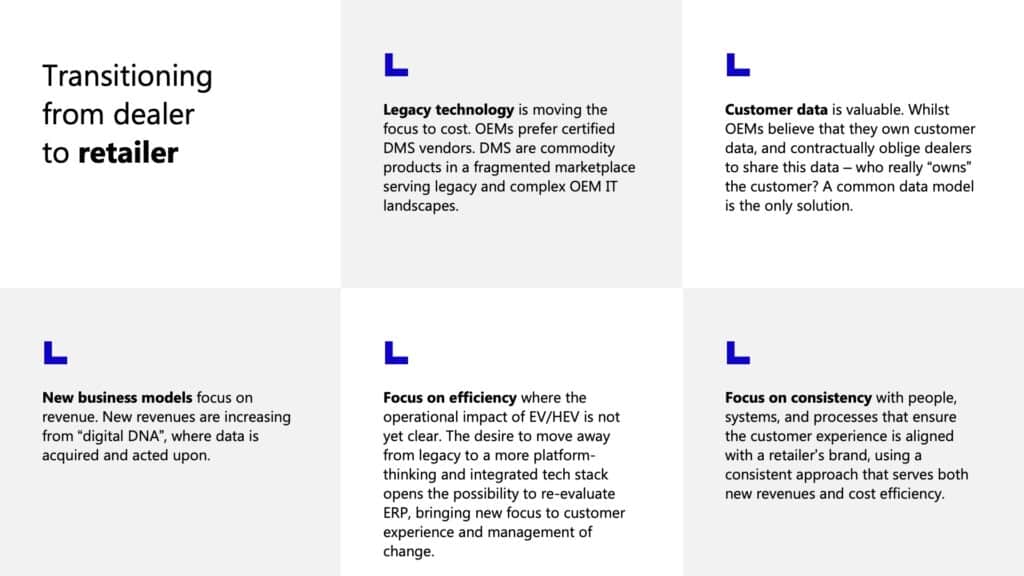


The issue of customer data ownership emerged as a critical dilemma, with OEMs claiming ownership. Phillip urged the industry to find ways for all parties to access and utilize this data. The revenue model is anticipated to shift from transaction-based vehicle sales to selling services and subscription models. As the industry undergoes this transformation, operational efficiency, especially with the impact of electric and hybrid vehicles on aftersales services, becomes paramount.


Highlighting the criticality of consistency in service offerings for customer retention, Phillip stressed the importance of dealers choosing the right technology, processes, and systems to maintain this consistency, thereby impacting the retailer’s brand. In summary, the key trends involve dealers evolving to focus more on retailing and less on traditional vehicle sales, necessitating adaptations in technology, business models, and customer engagement strategies.
AMAG’s forward-looking perspective
Frank Böhmerle of AMAG brought a visionary perspective, focusing on creating a more people-centric, sustainable, and digital future for the automotive industry. As Head of Strategy, Projects, and Innovation at AMAG Retail, Frank’s insights illuminated the ongoing transformation of the sector, with a particular emphasis on sustainability and digital innovation.
He underscored the need to adapt to megatrends shaping the industry, pointing out Switzerland’s unique characteristics as a small market with four official languages.
Frank delved into the changing purpose of vehicles, recognizing that in smaller cities and rural areas like Switzerland, the transformation might not be as rapid as in megacities. He highlighted the impact of technological changes, such as connected cars and autonomous technology, on the automotive business. The shift from hardware to software and the importance of meeting customer expectations for omnichannel experiences were also key considerations.
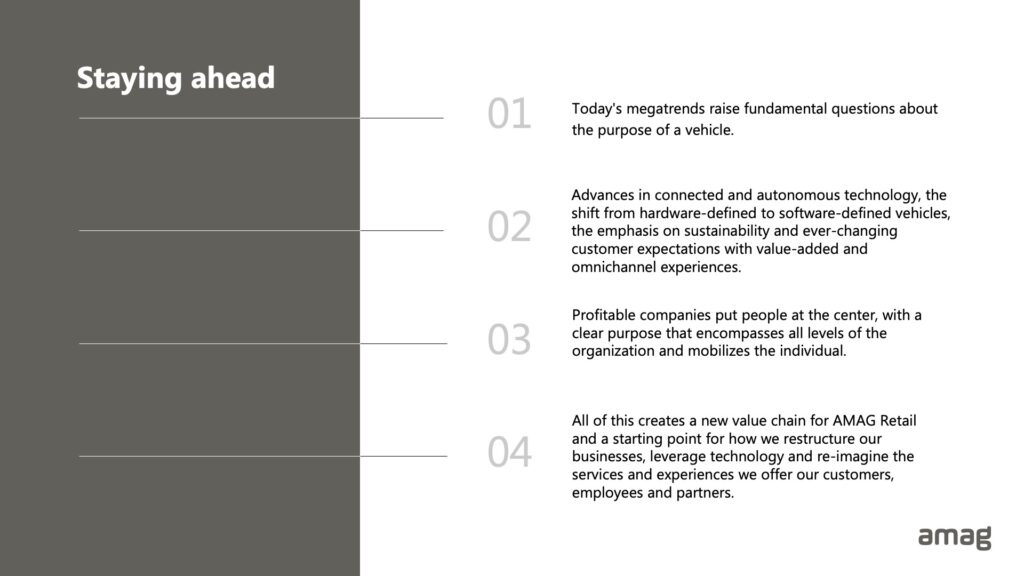
The discussion explored the critical role of employees and the necessity to place both customers and staff at the center of the transformation. Frank presented a scenario analysis projecting a 70% decrease in EBIT until 2030 if no action is taken. This emphasized the urgency for AMAG to focus on efficiency, customer loyalty, and the digitization of processes and customer interfaces.
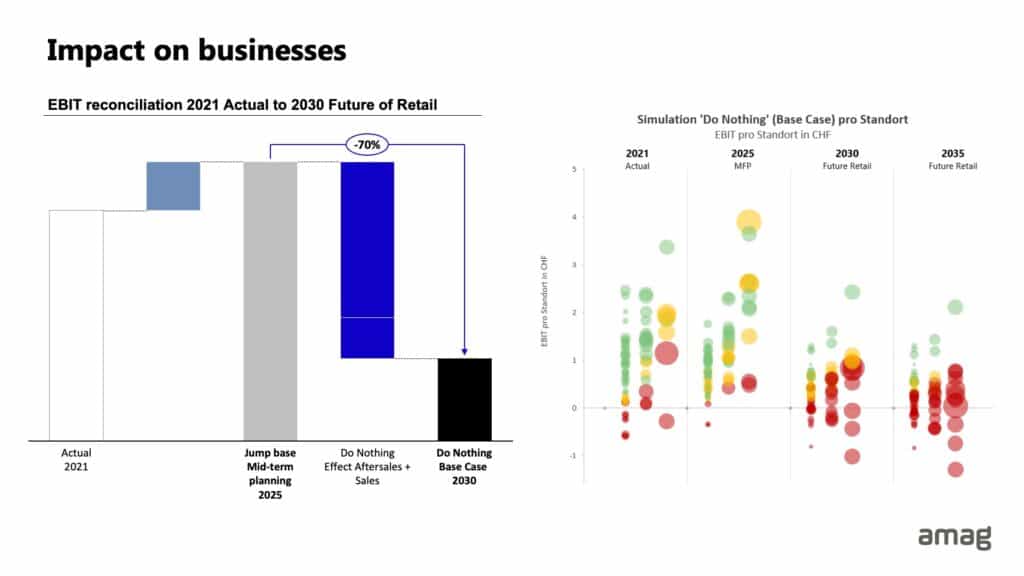

To counteract the decline in traditional vehicle sales, Frank outlined a comprehensive restructuring process that involved focusing on five strategic areas. These areas included increasing efficiency and customer loyalty in the core business, digitizing processes and customer interfaces, and exploring new business models such as retail as a service, mobility as a service, energy services, car as a service, and advanced mobility solutions.

Frank emphasized the importance of people, culture, leadership, talent management, and education in driving the transformation. He discussed the need for a flexible organizational structure and the implementation of technology solutions, including the adoption of Annata to facilitate faster and more efficient adaptation to new business models.
 Frank shared real examples of AMAG’s initiatives, such as partnering with Tesla, Lucid, and launching the Oride brand for mobility solutions beyond traditional car sales. He highlighted the establishment of a high-performing charging network and the acquisition of Helion to integrate car batteries into energy solutions for homes.
Frank shared real examples of AMAG’s initiatives, such as partnering with Tesla, Lucid, and launching the Oride brand for mobility solutions beyond traditional car sales. He highlighted the establishment of a high-performing charging network and the acquisition of Helion to integrate car batteries into energy solutions for homes.
AMAG’s future of automotive retail
The presentation concluded with a vision of integrated dealership spaces offering a range of services, including charging stations, micro-mobility, car wash, mobility hubs, convenience stores, showrooms, workshops, and test drive facilities, showcasing AMAG’s commitment to becoming a comprehensive mobility provider.
 Annata’s A365– Next-generation automotive retail technology
Annata’s A365– Next-generation automotive retail technology
Phillip emphasized the importance of adopting a platform-based approach with a standardized technology stack to address challenges in the automotive industry, particularly for companies like AMAG. The focus is on using standardized software and tools that come with built-in capabilities, including features related to machine learning and generative AI, such as Microsoft’s copilot.
He highlighted the shift from being a traditional dealer to becoming a retailer, with a strong emphasis on customer-centricity. The goal is to build a comprehensive 360-degree view of the customer within a unified system. Many businesses face the challenge of harmonizing multiple DMS (Dealer Management System) and CRM systems, and Phillip discussed the use of common data models to facilitate this integration.

Phillip clarified that Annata sees itself as more than just a DMS; it aims to be future-oriented and offers capabilities beyond traditional systems. While supporting the functions of legacy DMS and dealer systems is essential, Annata strives to provide a more comprehensive solution that aligns with the evolving needs of the automotive industry.
As the session concluded, the floor opened to a dynamic Q&A session, allowing the audience to engage directly with the wealth of insights shared by Frank, Magnus, and Phillip.
Their collective expertise on automotive retail, spanning visionary perspectives, industry landscapes, and technological innovations, provided a profound understanding of the current challenges and opportunities within the automotive sector. The relevance of their insights to the present-day automotive industry cannot be overstated, offering valuable guidance for navigating the digital transformation era.
For those who found this session enriching and enlightening, we invite you to stay connected with us for our upcoming webinars, where we continue to delve into the forefront of industry evolution.
If you missed any part of this enlightening discussion, the complete recording is available for your viewing, ensuring you don’t miss a moment of the valuable insights shared. Your journey into the future of automotive excellence has just begun—stay tuned for more thought-provoking discussions and innovative perspectives.

